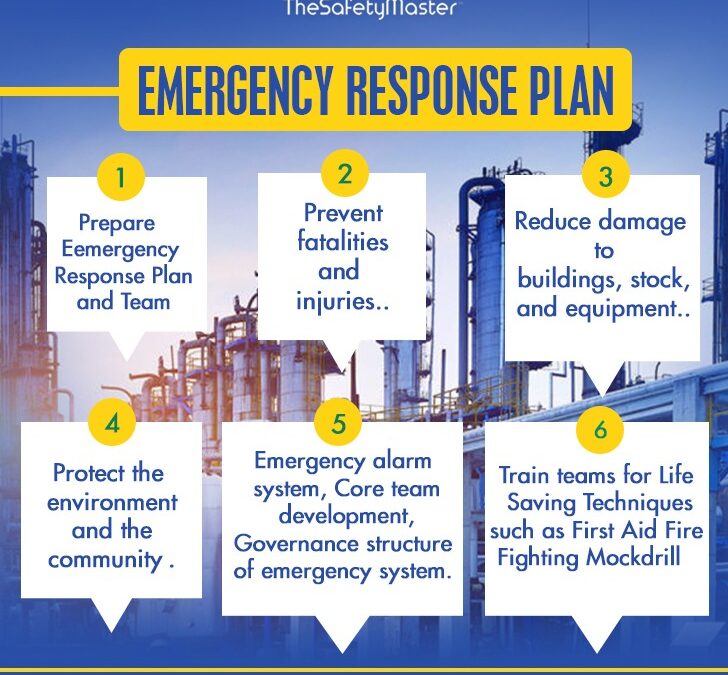Why Emergency Response Plans are Important

Emergency response plans are crucial for several reasons. Firstly, they help to minimize the risk of injury or loss of life during an emergency. By having a plan in place, individuals and organizations can quickly and effectively respond to an emergency, reducing the likelihood of harm to people and property. Secondly, emergency response plans help to reduce the economic impact of an emergency. By minimizing the damage and disruption caused by an emergency, organizations can reduce the financial costs associated with recovery and get back to normal operations more quickly. Finally, emergency response plans can help to protect the environment and prevent environmental disasters. By having a plan in place, organizations can quickly respond to environmental emergencies, such as oil spills or chemical leaks, and prevent further damage to the environment.
Key Elements of an Emergency Response Plan
A successful emergency response plan should include several key elements. These include:
- Emergency procedures: Clear procedures for responding to different types of emergencies, such as fires, floods, or medical emergencies.
- Communication plan: A plan for communicating with employees, customers, and emergency services during an emergency.
- Evacuation plan: A plan for evacuating people from a building or area in the event of an emergency.
- First aid and medical response: A plan for providing first aid and medical response during an emergency.
- Damage assessment and recovery: A plan for assessing and recovering from damage caused by an emergency.
- Training and drills: Regular training and drills to ensure that individuals and organizations are prepared to respond to an emergency.
Examples of Emergency Response Plans
Emergency response plans can be applied in different contexts, including:
- Workplace emergency response plans: These plans are designed to help organizations respond to emergencies in the workplace, such as fires, chemical spills, or medical emergencies.
- School emergency response plans: These plans are designed to help schools respond to emergencies, such as fires, earthquakes, or violent incidents.
- Community emergency response plans: These plans are designed to help communities respond to emergencies, such as natural disasters, floods, or power outages.
- Hospital emergency response plans: These plans are designed to help hospitals respond to emergencies, such as medical emergencies, fires, or power outages.
Creating an Emergency Response Plan
Creating an emergency response plan involves several steps. These include:
- Conducting a risk assessment: Identifying potential risks and hazards in the workplace, school, or community.
- Developing emergency procedures: Creating clear procedures for responding to different types of emergencies.
- Establishing a communication plan: Creating a plan for communicating with employees, customers, and emergency services during an emergency.
- Conducting training and drills: Providing regular training and drills to ensure that individuals and organizations are prepared to respond to an emergency.
- Reviewing and updating the plan: Regularly reviewing and updating the emergency response plan to ensure that it remains effective and relevant.
Frequently Asked Questions (FAQs)
- What is an emergency response plan?
An emergency response plan is a document that outlines the procedures to be followed in the event of an emergency. - Why do I need an emergency response plan?
You need an emergency response plan to minimize the risk of injury or loss of life during an emergency and to reduce the economic impact of an emergency. - What should be included in an emergency response plan?
An emergency response plan should include emergency procedures, communication plan, evacuation plan, first aid and medical response, damage assessment and recovery, and training and drills. - How often should I review and update my emergency response plan?
You should review and update your emergency response plan regularly, ideally every 6-12 months, to ensure that it remains effective and relevant. - Who should be involved in creating an emergency response plan?
The creation of an emergency response plan should involve a team of individuals, including management, employees, and emergency services.
Conclusion
In conclusion, emergency response plans are critical for minimizing the risk of injury or loss of life during an emergency and reducing the economic impact of an emergency. By having a well-thought-out emergency response plan in place, individuals and organizations can quickly and effectively respond to emergencies, reducing the likelihood of harm to people and property. The key elements of a successful emergency response plan include emergency procedures, communication plan, evacuation plan, first aid and medical response, damage assessment and recovery, and training and drills. By following the steps outlined in this article and regularly reviewing and updating their emergency response plan, individuals and organizations can ensure that they are prepared to respond to emergencies and minimize the impact of disasters. Remember, preparation is key to saving lives, and having an emergency response plan in place is the first step towards a safer and more resilient future.
Closure
Thus, we hope this article has provided valuable insights into Emergency response plans. We appreciate your attention to our article. See you in our next article!